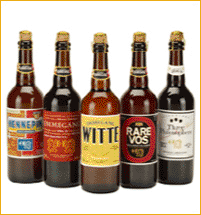
Editor’s Note: This sponsored column is written by Nick Anderson, beermonger at Arrowine (4508 Lee Highway)
Well, Sandy came and went this week and for the most part we managed to get through okay. Beyond starting to expect intense storms every Halloween, I think we could all stand to kick back and enjoy a beverage or two now that the downpour has stopped. Here are some brews that may just be appropriate for the occasion:
Heavy Seas Winter Storm: I mean, start with the obvious, right? This strong ESB from Baltimore’s Heavy Seas brewery is a malty Ale with focused sharpness of its hops. Winter Storm is crisp enough for autumn weather and just robust enough to take care of you when the temperature drops.
Maui Big Swell IPA: This Hawaiian offering features some of the most popular hops going right now (Columbus, Chinook, Centennial, Simcoe, Citra) but manages to stay short of caricature. Sharp and clean, Big Swell is perfect for post-high tide drinking.
Evil Twin Hop Flood: What? It’s a theme column; I gotta do what I gotta do. This Amber Ale from gypsy brewery Evil Twin is not nearly as overwhelming as its name suggests. In fact, Hop Flood is earthier than it is citrusy or aggressive. It’s a fine beer that can be hard to find but is delicious.
Bell’s Java Stout, Founder’s Breakfast Stout, Southern Tier Jah’Va: These robust dark beers will give you some good coffee notes and help keep you warm after we dive full-stop into winter, which knowing this area should be in the next week or two. The Bell’s Java Stout is for espresso drinkers—intense and earthy. Jah’Va is rich with a fuller mouthfeel and a pronounced coffee bean note. Founder’s Breakfast Stout is an autumn/winter favorite of mine every year, and uses two types of coffee and two types of chocolate along with some oatmeal in the malt bill. If you don’t have the time (or electricity) to make breakfast, you could certainly do worse.
Devils Backbone Long Winter’s Nap: This is a recent arrival but already popular not only with Arrowine customers but myself as well. This brew doesn’t feel anywhere near its 10% ABV, but its smooth feel makes it a deceptively easy treat. This seasonal will put you down for that long winter’s nap if you’re not careful—unless that’s what you’re looking for, of course.
Sierra Nevada Celebration Ale: We made it through the hurricane—why not celebrate? Look for this on tap starting this week and on retailer shelves in the next week or two. This Ale is a great way to get your hop fix without going too absurd or overpowering. Many like to age Celebration, but I’m of the mind that fresher is better.
I hope you all came through the storm in good shape, and will see you back here next week.
Cheers!
Nick Anderson maintains a blog at www.beermonger.net, and can be found on Twitter at @The_Beermonger. Sign up for Arrowine’s money saving email offers and free wine and beer tastings at www.arrowine.com/mailing-list-signup.aspx. The views and opinions expressed in the column are those of the author and do not necessarily reflect the views of ARLnow.com.




